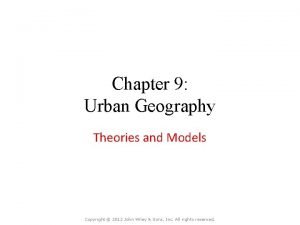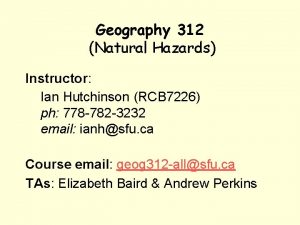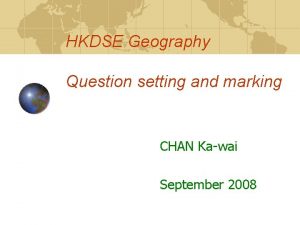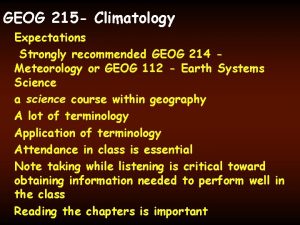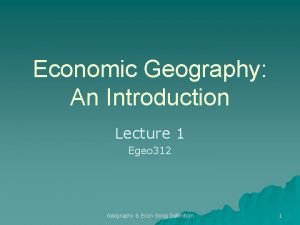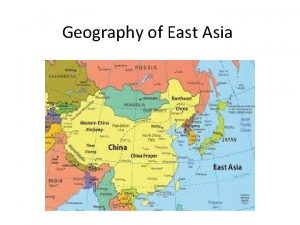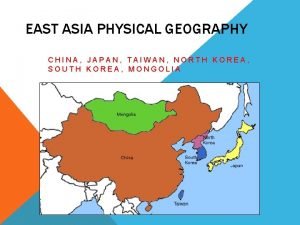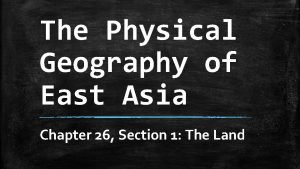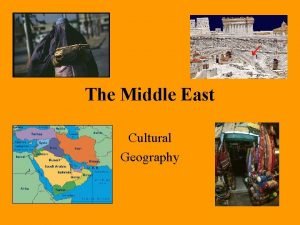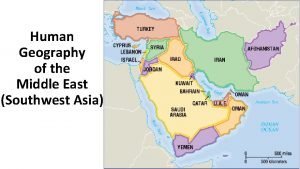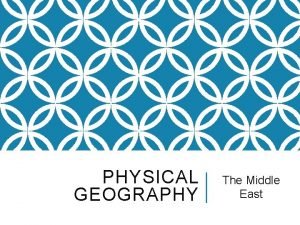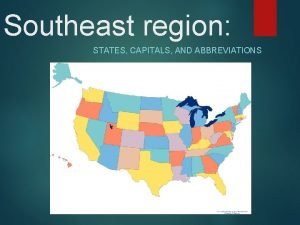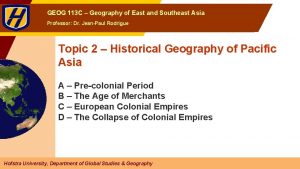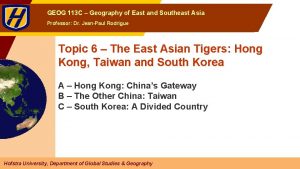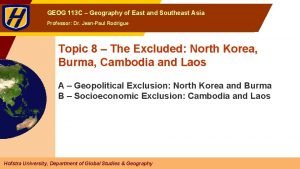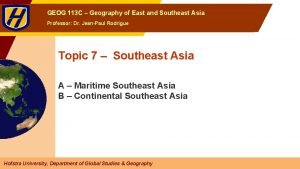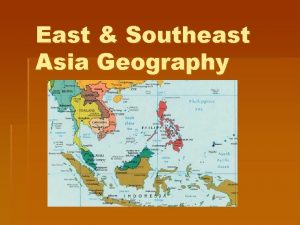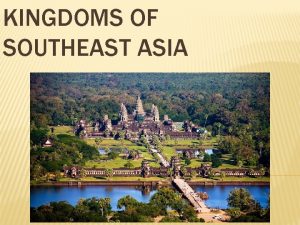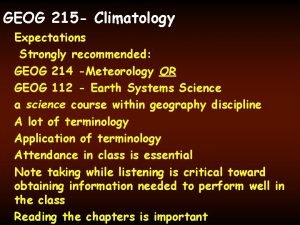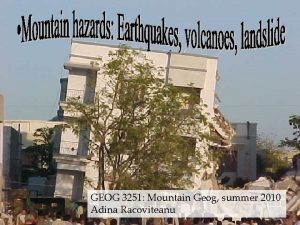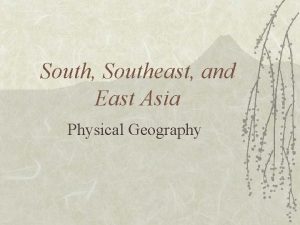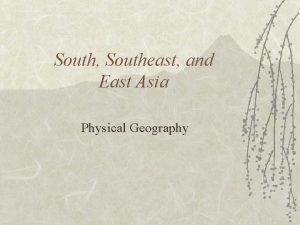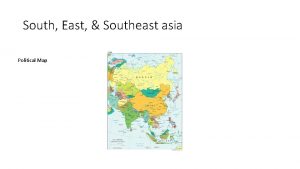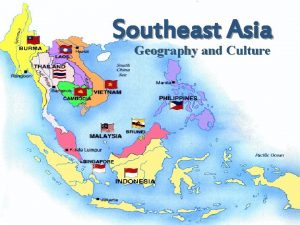GEOG 113 C Geography of East and Southeast





















- Slides: 21

GEOG 113 C – Geography of East and Southeast Asia Professor: Dr. Jean-Paul Rodrigue Topic 4 – Japan and its Corporate Hegemony A – Geography and the Insularity of Japan B – Japanese Development C – The Corporate and Industrial Hegemony Hofstra University, Department of Global Studies & Geography

A. GEOGRAPHY AND THE INSULARITY OF JAPAN 1. Location In which way the location of Japan is unique? 2. Maritime Orientation How the ocean is influencing the Japanese society? 3. Demography What characterizes the Japanese population? 4. Resources Is Japan lacking resources? © Dr. Jean-Paul Rodrig

1. Location and Insularity ■ Location • “jih-pen” in Chinese (sun’s origin): • Since Western civilizations encountered China before Japan, the name “Japan” stuck. Contemporary Flag • Nihon (or Nippon), meaning “Source of the sun”. • Relative isolation in Pacific Asia: • Insularity. • Do not share a land border with any country. • Maritime access: Imperial Flag • Shimaguni (island country) / insularity. • Labeled as the Great Britain of the Pacific. © Dr. Jean-Paul Rodrig

Changes in Japan’s Relative Location From Terminus… • • • Limited outside influence (insularity). Writing, Buddhism and Confucianism came from China, via Korea. Protected from Chinese (Mongol) and Korean invasions. End of maritime roads from Europe. Closest Asian country from North America. Core of the transpacific trade. … To Hub © Dr. Jean-Paul Rodrig

2. Maritime Orientation ■ Maritime space • 4 islands; 98% of the land mass: China North Korea South Korea Russia Hokkaido (83, 400 km 2). Honshu (231, 100 km 2). Shikoku (18, 700 km 2). Kyushu (42, 100 km 2). • 3, 500 islands in two major groups (Ryukyu and Bonin). • Several large bays: Sea of Japan Honshu Kyushu Shikoku • • Tokyo Bay Nagoya Bay Osaka Bay • Tokyo, Nagoya and Osaka. • Important concentration of port infrastructures and urban regions. • Arc of over 1, 700 miles. • Coastline: • 19, 000 miles. • 3 rd in the world behind Russia and Australia. © Dr. Jean-Paul Rodrig

2. Maritime Orientation ■ Linking the main Japanese islands Hokkaido 3 • Required the construction of bridges and tunnels. • Impressive engineering achievements. • 1) Seto-Ohashi bridge: • Shikoku/Honshu. • Naruto Strait. Honshu 2 1 Kyushu Shikoku • 2) Kanmon bridge: • Strait of Shimonoseki. • Kyushu/Honshu. • 3) Seikan tunnel: • Tsugaru Strait (Honshu/Hokkaido) • 33 miles, 1988, longest in the world. © Dr. Jean-Paul Rodrig

2. Maritime Orientation ■ Physical constraints Hokkaido Kanto Plain Kyushu • 16% of the land is habitable. • Most of the population lives on 0. 3% of the territory. • Fight against the scarcity of space: Honshu Yamato Plain Shikoku • Physical geography increases the territorial exiguity. • An “empty” country: Nobi Plain • Long narrow valleys. • Concentration of agricultural productivity. • Efficient management of existing agricultural land. • Kanto plain: • 30. 5% of the population. • 8. 3% of the surface of Japan. • 50% of the flat territory. © Dr. Jean-Paul Rodrig

2. Maritime Orientation ■ Fishing • Insularity and fishing have influenced Japanese food supplies: • 25% of protein coming from fishes (6% world average). • Japan has the most important fishing fleet in the world. • Massive usage of aquaculture (shrimp, oysters, seaweed). • Fishing is favored by the meeting of two currents: • Kuroshio (warm and salty). • Oyashio (cold). • Enabling better plankton growing conditions. ■ Diet • Unique diet the outcome of geography. • Rice is the main staple food: • Soybean as a source of protein (tofu, shoyu). • Meat not part of the diet until 20 th century. © Dr. Jean-Paul Rodrig

Evolution of the Japanese Diet (kg / capita / year) 400 350 300 Oils & Fats Fish & Shellfish 250 Milk & Dairy Products Eggs 200 Meat Wheat 150 Rice Grains 100 50 0 1936 1960 1970 1995 © Dr. Jean-Paul Rodrig

2. Maritime Orientation s ■ Climate in t er w in d Oyashio Cold C ol d w Hokkaido Honshu Kyushu • Japan is the meeting place of the important weather patterns. • Temperate. • Monsoons warm air masses from the south. • Siberian cold air masses from the north. • High precipitations. Shikoku ■ Three major climate regions Kuroshio (Black current) Warm and salty. • North: temperate climate with cold winters and important snowfalls. • Center: east/west variation. • South: subtropical climate. © Dr. Jean-Paul Rodrig

2. Maritime Orientation ■ Seismic activity • Meeting of 3 tectonic plates • Most active in the world. • 1, 500 earthquakes a year (about 30 are felt). • Process of subduction. Eurasian Plate Philippines Plate Pacific Plate 2011 Sendai Earthquake ■ Volcanic activity: • 10% of the world’s active volcanoes (200): • About 40 volcanoes are currently active. • Mount Sakurajima (Kyushu) erupted more than 5000 times since 1955. • Mount Fuji last erupted in 1707. • Numerous hot springs. © Dr. Jean-Paul Rodrig

2. Maritime Orientation ■ Earthquakes • Influence construction materials, construction techniques and lifestyle. • The 70 years rule: • Tokyo affected by a major earthquake every 70 years (1633, 1703, 1782, 1853, 1923, 2011). • Great Kanto earthquake (1923): • 8. 3 MMS (moment magnitude scale). • 100, 000 – 140, 000 deaths. • Kobe 1995: • • 6. 8 MMS. 6, 400 deaths and 250, 000 made homeless. 30, 000 damaged buildings. Reconstruction costs: between 2 and 3% of GDP. Japanology Plus - Earthquake resistant Architecture © Dr. Jean-Paul Rodrig

2. Maritime Orientation Discuss the unique characteristics of the physical geography of Japan. • 2011 Sendai earthquake and tsunami: • • 9. 0 MMS. Largest in recorded history to hit Japan. 4 th largest in recorded history. Triggered a 10 meters tsunami. The island of Japan moved by 2. 4 meters. The earth axis shifted 10 centimeters. 10, 000 deaths. Problems with three nuclear reactors at Fukushima plant that were tested to withstand a 7. 9 scale earthquake. Tsunami in the Sendai Airport area, Miyagi Prefecture, helicopter view © Dr. Jean-Paul Rodrig

3. Demography ■ Demographic and cultural homogeneity Language Japanese Other Ethnicity • 126 million. • 99% of the population is of Japanese ethnicity. • 99% of the population speaks Japanese. • Foster national identity and unity. • Issue of conformity. • “Yamato people” (plain around Kyoto). • Distrust of foreigners. • Literacy rate of 99%. ■ Immigration Japanese Other • Ethnic homogeneity does not favor immigration. • Would need 400, 000 immigrants a year to stabilize population. © Dr. Jean-Paul Rodrig

Population of Japan, 1870 -2050 140, 000 120, 000 100, 000 80, 000 Real Projected 60, 000 40, 000 20, 000 0 1820 1870 1920 1970 2020 2070 © Dr. Jean-Paul Rodrig

3. Demography ■ Aging Japan: TFR • Population peaked at 128 millions. • Declined in 2009, for the first time since census was held (1899). • 126 million as of 2018. • Highest life expectancy in the world: 4 3. 5 3 • 86 years for females. • 79 years for males. 2. 5 • More people over 65 than children under 15 (30, 000 people more than 100 years). 2 • Older age of marriage, around 27 years. • Many Japanese women do not marry (subservient relation). • Low fertility rate, about 1. 3 children per woman. 1. 5 1 0. 5 0 1950 1970 1990 2010 • Net decline of the active age population since 1997. • Decline in savings rate. • From net savers to net borrowers. © Dr. Jean-Paul Rodrig

Population Pyramid of Japan Female Male 2. 30 3. 05 3. 60 4. 02 5. 14 4. 03 3. 83 4. 08 4. 82 4. 91 4. 09 3. 67 3. 21 3. 11 3. 09 -6 -4 (1 0 (9 0 5(9 +) 9 0(8 0. 21 9) 9 50. 55 (8 4) 8 0(7 1. 18 9) 8 5(7 4) 8 0(6 0) 7 5(6 4) 6 0(5 9) 6 5(5 4) 5 0(4 9) 5 5(4 4) 4 0(3 9) 4 5(3 4) 3 0(2 9) 3 5(2 4) 2 0(1 9) 2 5(1 4) 1 09) (5 1 4) (0 9) - -2 4) 0. 02 0. 17 0. 63 1. 26 2005 2. 15 3. 06 3. 64 3. 99 4. 38 5. 09 4. 05 3. 80 4. 01 4. 65 4. 70 3. 91 3. 50 3. 05 2. 94 2. 93 0 Millions 2 4 6 -6 (1 0 (9 0 5 Female (9 0. 13 +) 9 00. 58 (8 9) Male 9 5(8 1. 35 4) 8 0(7 2. 23 9) 8 5(7 3. 26 4) 7 0(6 4. 36 9) 7 5(6 4. 10 4) 6 0(5 3. 70 9) 6 5(5 3. 87 4) 5 0(4 4. 17 9) 5 5(4 4. 66 4) 4 0(3 4. 02 9) 4 5(3 4. 82 4) 3 0(2 3. 22 9) 3 5(2 3. 16 4) 2 0(1 3. 26 9) 2 5(1 2. 99 4) 1 02. 88 9) (5 1 2. 71 4) (0 9) 2. 46 4) -4 -2 0. 12 0. 54 2020 1. 41 2. 43 3. 15 3. 92 4. 76 4. 26 3. 71 3. 86 4. 22 4. 79 4. 22 4. 65 3. 31 3. 91 2. 88 2. 76 2. 73 2. 56 2. 33 0 2 4 6 Millions © Dr. Jean-Paul Rodrig

Explain some of the demographic challenges that Japan is facing. Life Expectancy at Birth, 1910 and 2015 United States 49 53 Sweden 57 Japan 81. 6 76. 9 80. 7 59 UK 49 40 2015 Females 84. 8 80. 5 47 46 30 86. 8 80. 5 43 43 Italy 84 79. 4 53 50 2015 Males 60 1910 Females 70 1910 Males 80 83 90 © Dr. Jean-Paul Rodrig

4. Resources ■ Small resource base • Limited quantities of minerals and fossil fuels. • Japan needs to import most of its resources: • Favored the development of trade. • Industrial corporations and banks are controlling a significant array of foreign resources. • Small territory makes agricultural self sufficiency difficult: • One of the highest agricultural productivity. • 60% of all food is imported. • Issues: • Stability and reliability of partners. • Price fluctuations. • Must produce something in exchange. © Dr. Jean-Paul Rodrig

4. Resources ■ Energy 2017 39 Petroleum Coal Natural Gas Nuclear Hydro Others 2007 47 0% 50% • Dependence on fossil fuels. • Hydroelectricity and geothermal energy have good potential. • Japan relies on nuclear energy. • Issue of energy security: • Imports 84% of its energy. • Diversify energy supplies notably from new regional producers (Indonesia, Brunei). • Sharp drop in the use of nuclear energy (Fukushima). 100% © Dr. Jean-Paul Rodrig

Dependency of Japan on some Raw Materials and Agricultural Goods, 1992 29. 9 Meat Zinc 82. 7 Wheat 84. 8 Lead 86. 0 Coal 91. 0 Soya 95. 5 Natural Gas 96. 0 Copper 99. 6 Iron Ore 99. 6 Oil 99. 7 Corn 100. 0 Cotton 100. 0 Wool 100. 0 Nickel 100. 0 0 10 20 30 40 50 60 70 80 90 100 © Dr. Jean-Paul Rodrig
 Products of the southeast region
Products of the southeast region Lesson 1 physical geography of southeast asia
Lesson 1 physical geography of southeast asia Southeast asian city model definition ap human geography
Southeast asian city model definition ap human geography East is east and west is west
East is east and west is west Unit 1 geog. of ga/ga’s beginnings
Unit 1 geog. of ga/ga’s beginnings May subd geog
May subd geog Geog 312 sfu
Geog 312 sfu Hkdse geography 2020
Hkdse geography 2020 Geog 214
Geog 214 Geog
Geog East south east wind direction
East south east wind direction North american
North american Phy 113 past questions and answers
Phy 113 past questions and answers Gst 113
Gst 113 Asia geography
Asia geography Physical geography of east asia
Physical geography of east asia Chapter 27 physical geography of east asia
Chapter 27 physical geography of east asia Physical geography of east asia
Physical geography of east asia Ethnic groups in the middle east
Ethnic groups in the middle east Human geography of middle east
Human geography of middle east Physical geography of middle east
Physical geography of middle east Southeast region abbreviations
Southeast region abbreviations


